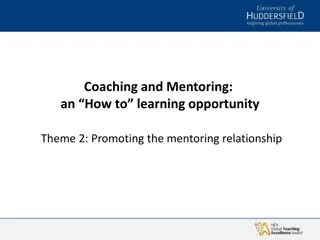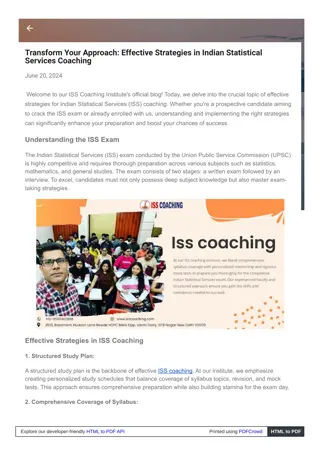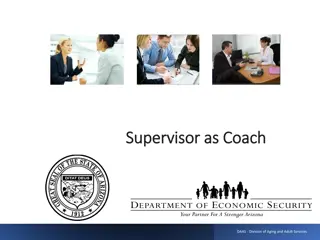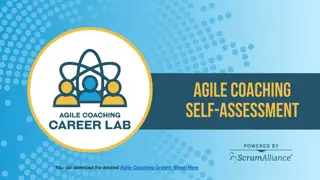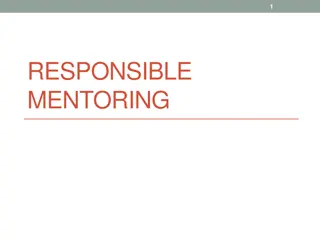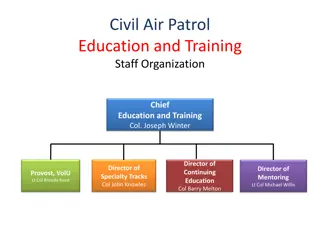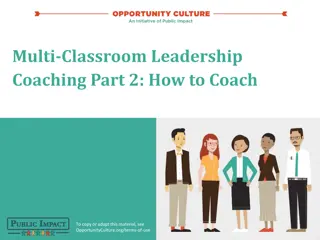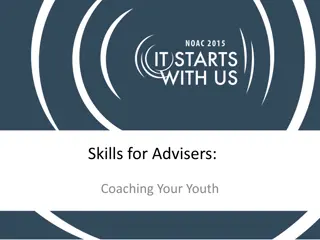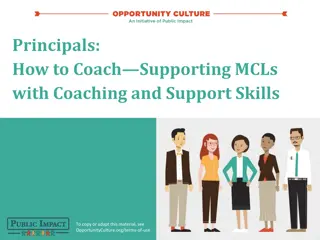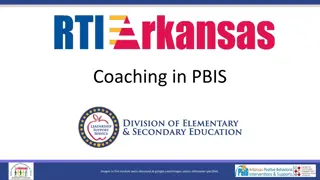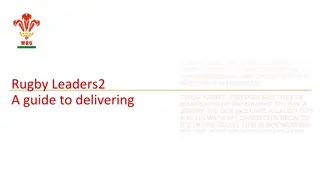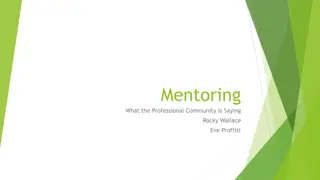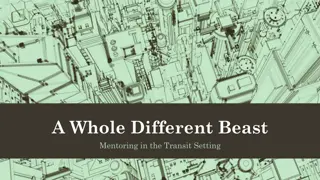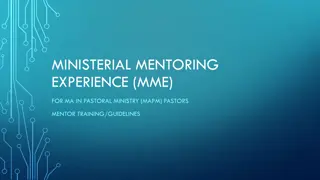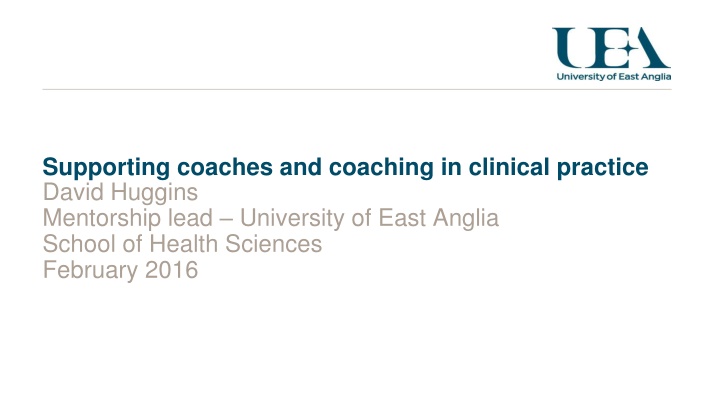
Supporting Coaches and Mentors in Clinical Practice: Key Educational Processes and Challenges
Explore the essential educational processes and challenges involved in supporting coaches and mentors in clinical practice. Delve into coaching and mentorship models, clinical skill development, reflective practice, and more. Understand the intertwining of mentorship and coaching, along with various mentoring models to enhance mentor-mentee relationships.
Download Presentation

Please find below an Image/Link to download the presentation.
The content on the website is provided AS IS for your information and personal use only. It may not be sold, licensed, or shared on other websites without obtaining consent from the author. If you encounter any issues during the download, it is possible that the publisher has removed the file from their server.
You are allowed to download the files provided on this website for personal or commercial use, subject to the condition that they are used lawfully. All files are the property of their respective owners.
The content on the website is provided AS IS for your information and personal use only. It may not be sold, licensed, or shared on other websites without obtaining consent from the author.
E N D
Presentation Transcript
Supporting coaches and coaching in clinical practice David Huggins Mentorship lead University of East Anglia School of Health Sciences February 2016
Aims and objectives To identify key educational processes used to support learners in clinical practice To review basic education teaching and learning styles To recap and expand on coaching and mentorship models To review the importance of a coaching conversation between a coach and a coachee s To understand and implement clinical skill s and competency in coaches and coachee s To support reflective practice To ensure feedback and feed forward are correctly utilised
CE role key aspects CE role is pivotal in supporting mentors/coaches in the workplace. Understanding the key issues such as NMC Standards and HEI process is key Other key elements include, theories of mentorship/coaching, education theory, learning styles, developing skills and competence as well as developing and supporting reflective practice. CEs need to support the process of feeding forward and feeding back to mentors and students.
Challenges ? Selling the role Being seen as the expert Developing as you go Who can support you? Differences between coaching and mentorship Managing change Motivation
Mentorship and coaching Seen as intertwined Many definitions so staff confusion exists? Tobin (2004) see coaching as one of 7 characteristics of being a good mentor. (Others are teacher, sponsor, adviser, agent, role model and confidante) Comte-Sponville (2003) see the key qualities being empathy, maturity, self confidence, resourcefulness and willingness to commit time and energy to others Do we all have these qualities?
Mentoring models Classical mentoring (natural, mutual self chosen relationship) Reflective mentoring (based on learning theories i.e. andragogy, styles of learning and student-centred approaches. Mentor is a critical friend and co-enquirer). Apprenticeship model (mentor is a skilled craftsperson and the mentee learns by copying their Competence-based model (mentor enables mentee to achieve a set of practice objectives) Team-mentoring (A team of mentors mentor one or more students) Contract mentoring (Formal mentoring that is time/objectives restricted) Pseudo-mentoring (Appearance only and usually for a specific task i.e. supervision of a dissertation) (Gopee 2015)
Coaching Seen by Race (2010) as the highest form of learning. One to one Group/team Systems Other models GROW, NLP, spiral and so on. Definitions vary Hudson (1999:22) sees coaching as ..the art of guiding another person, persons or human systems towards a fulfilling future Coaches help the clients invent futures that are exciting, valuable and intensely personal. Coaching is (therefore) more about doing than being . Coaching can be a powerful resource when it is done by highly competent and experienced coaches in appropriate circumstances (Neal et al 2009)
Coaching conversation Key to setting aims and objectives Coachee encouraged to set their own aims and objectives (GROW?) Goal, Reality, Options and Wrap Use of SMART Use of a model for identifying the correct course of action (adapted from Egan 1998) Questions asked in model What is your goal? How will you know when you ve achieved it? How much of it do you think you will achieve/ What style of coaching do you prefer? Answers To clinically examine a patient To be able to combine theory and practice The examination part but not the theory Communication style When would you like your goal to be achieved? How long do you think it will actually take, and why? In one year? 18 months, because not enough time can be spent in clinical practice
Communication Pivotal to everything Remember verbal and non verbal's Listening skills (interactive). Ideal skill to coach How is power affecting things (mentor/coach/CE and all in practice)? Interaction is key clarifying, verifying and reflecting? Use empathy in your communication. 6 C s in mentorship (Duffy 2015) Makes coaches become insider experts by having interactive listening skills.(Hameric et al 2000).
Educational theory. A reminder Domains of learning Blooms (1956) taxonomy Andragogy and pedagogy Educational theories Learning styles Teaching methods
Nursing curriculum 2011 Bronfenbrenner s Bio-Ecological Model (2005)
Skills development and competency Helping coachee s reach competency Difference between confidence, competent and competency? Confidence is generally described as a state of being certain either that a hypothesis or prediction is correct or that a chosen course of action is the best or most effective. Self-confidence is having confidence in oneself. Overall knowledge, skills and attitude. (Their Fitness to Practice) NMC (2004) see a competent nurse as one who consistently demonstrates fitness to practice. Specific clinical skills indicate competency. Dreyfus (1980)model, Benner (1984) and Millers (1990)pyramid.
Reflecting and giving Feedback Fluffy process? Model to use? Schon (1983) Gibbs (1998), Driscoll (2003), Rolfe (1997), Johns (2006), De Bono (1987) etc Constructive feedback and feed forward essential but often poorly done. Students want this on ALL aspects of their performance. Use a model I.e. Pendleton's rules of 4 steps ( Benson 2005) What has gone right What are the coachee s strengths followed by coaches views on this What needs to be improved (coachee s and coaches views) Develop an action plan.
Motivation Motivation is goal-directed behaviour Motivational influences (good and bad) Maslow (1943) Herzberg et al (1959) McClelland (1987) McGregor s theory x and y (1960) Vroom (1964) - - - - -
Summary Clinical Educators play a vital role in supporting learning in clinical practice. Challenges exist! Be aware of support available Keep updated on education theory and put theory into practice. Have a good understanding Use good communication skills Keep your self motivated and be a role model (6 C s)
References/reading Benson BJ (2005) Medicine Paediatrics Residency Programme: Ward feedback Benner P (1984) From Novice to Expert: Excellence and power in clinical nursing practice. Addison Wesley. Menlo Park. CA. Bloom BS, Englehard MD, Furst EJ, Hill WH, Krathwohl DR(1956) Taxonomy of educational objectives: The classification of educational goals. Handbook Cognitive domain, David McKay, New York Bronfenbrenner s Bio-Ecological Model (2005) Making human beings human: Bioecological perspectives on human development. Thousand Oaks, CA: Sage Publications. Comte-Sponville A (2003) A Short Treatise on the Great Virtues: The use of philosophy in everyday life. Vintage. London. DeBono E (1987) 6 Thinking hats: Penguin books. London. Dreyfus S and Dreyfus H (1980) A Five-Stage Model of the Mental Activities Involved in Directed Skill Acquisition. California. Driscoll MP (2003) Psychology of Learning for instruction. Allyn and Bacon. Needham. MA. Duffy K (2015) Integrating the 6 C s of nursing into mentorship practice. Nursing Standard. 29, 50, 49-58. Egan G (1998) The Skilled Helper: A problem management approach to helping. 6thEd. Brookes Cole .London. Gibbs G (1988) Learning By Doing: A Guide to Teaching and Learning Methods. FEU. London Gopee N (2015) Mentoring and Supervision in Healthcare. Sage. London. Herzberg, F, Mausner, B. and Snyderman, B.B. (1959), The Motivation to Work, Wiley, New York, NY Hudson FM(1999) The Handbook of Coaching. Jossey-Bass. San Francisco. Johns C (2006) Engaging Reflection in Practice: A Narrative Approach. Blackwell Publishing Ltd, Oxford. MacGregor DM (1960) The Human Side of Enterprise, McGraw Hill Book Co., New York, NY. Maslow, A.H. (1943), A theory of human motivation , Psychological Review, Vol. 50, pp. 370 96 . McClelland D (1987) Human Motivation. Cambridge University Press Miller GE (1990) The assessment of clinical skills/competence/performance. Academic Medicine, 65, 563-567. NMC (2004) Fitness to Practice. Nursing and Midwifery Council.London. Race P (2010) Making it Happen: A guide for Post-compulsory Education. Sage. London. Rolfe G (1997) Beyond expertise: theory, practice and the reflexive practitioner. Journal of Clinical Nursing, 6 (2), 93 97. Schon D (1983) The Reflective Practitioner. How professionals think in action. Avebury Press. London. Tobin MJ (2004) Mentoring: seven roles and some specifics. American Journal of Respiratory and Critical Care Medicine. 170, 114-117. Vroom V (1964) Work and motivation. Oxford, England: Wiley

